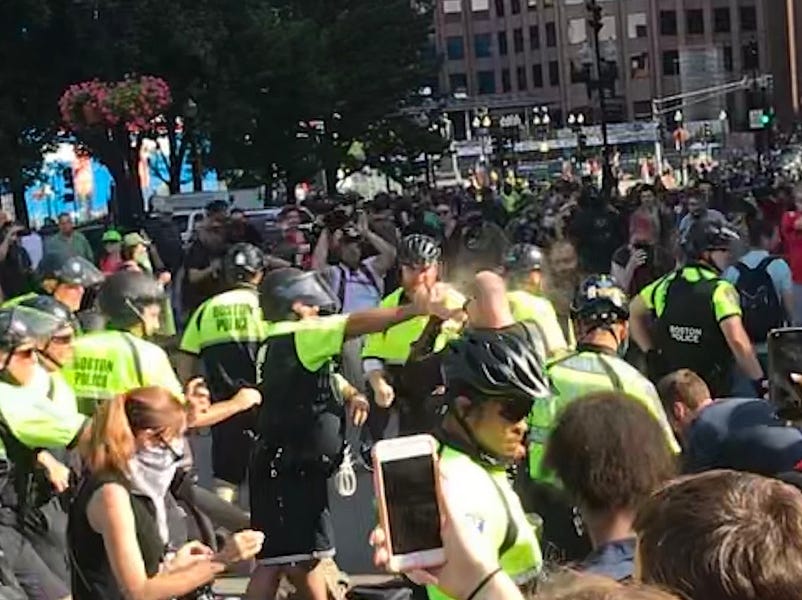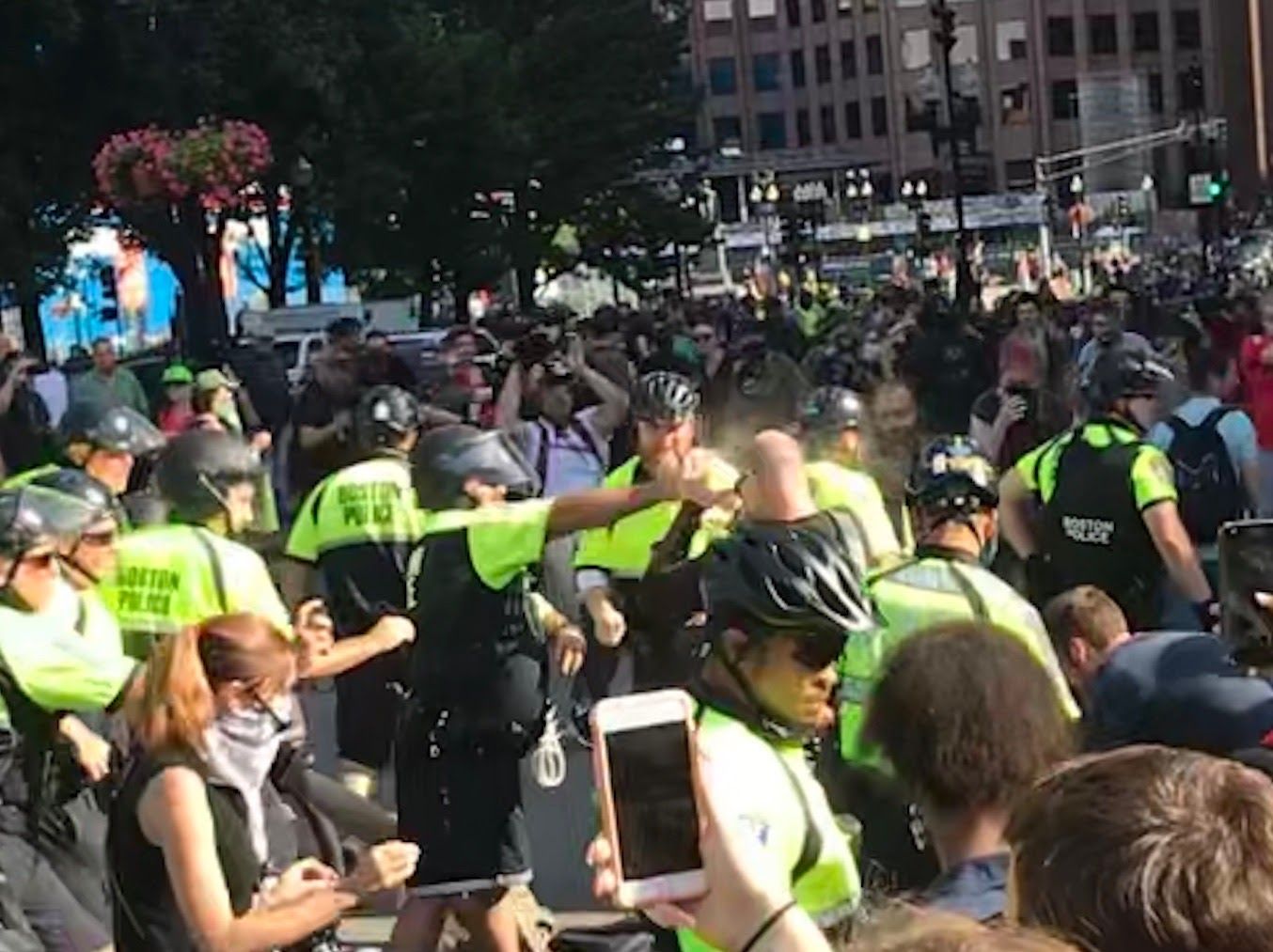Fear Itself
In the post-9/11 era, police departments blur the lines that separate them from spy services. More and more Americans get the treatment the CIA gives our non-American comrades


Edited by Spencer Ackerman
THE POLICE ARE AFRAID. Sometimes they’re afraid of the abstract things that scare all of us—personal injury or death, embarrassment, public censure—and sometimes they’re just afraid of people—environmentalists, black separatists, unarmed college students. All of these fears animate the threat assessments, news roundups, and other widely distributed interdepartmental memos that circulate among cops, made public last year by anti-secrecy organization DDoSecrets, always with military jargon emplaced wherever feasible. “IED destroys mailbox” is a regular feature of TRIPwire, the breathless crime blotter publication issued by Homeland Security. And no cop shop fears nonviolent leftists more than the Boston police department.
Local police departments across the Boston metro area get quarterly threat assessments from the Boston Regional Intelligence Center (BRIC), a Department of Homeland Security “fusion center” uniting federal and local law enforcement. The BRIC’s warnings are dire. In 2018, protesters from Massachusetts were arrested near an oil pipeline in West Virginia. They “delayed construction for approximately two hours” before being charged with a number of offenses. That quote is from a BRIC threat assessment, dated Q2 2018, categorizing delayed pipeline construction under the heading “domestic terrorism.”
The same rubric of domestic terrorism applies to a paragraph about the dangers of “black separatism,” one containing no specifics at all, suggesting that black separatists would radicalize Native Americans. A half-pager dealing with anarchists cited vandalism in Canada as domestic threat evidence.
BRIC is also scared of people doing leftist things even if they’re separated from Boston by an ocean. A different threat assessment notes under the “domestic terrorism” heading that “13 individuals affiliated with Extinction Rebellion disrupted an oil industry dinner at the National Museum of Scotland in Edinburgh.” Generally speaking, “domestic” means “in this country;” there is a separate section of these documents for foriegn threats. The National Museum of Scotland is here. Massachusetts is here. Extinction Rebellion operates primarily in Europe (to which, again, the greater Boston metropolitan area does not extend). The only conclusion I can reach is that environmentalists who speak English are so terrifying they must seem to BRIC to be just down the street, no matter how far away they actually are.
The encroaching menace of leftism preoccupies them: “[Extinction Rebellion] has acted out criminally at several demonstrations in the UK/Europe in the past,” BRIC wrote in July 2019. “They also have several offshoots in the US, including the Boston area, but have engaged in limited criminal activity locally.” From the same assessment, under the subheading “pro-life/pro-choice extremists” (which, again, includes civil disobedience on one side and murder on the other): “Seven counter-protesters were arrested at a pro-life rally on Boston Common on 1 June 2019 after assaults occurred between the two groups and an unknown liquid, possibly urine, was thrown on a pro-life demonstrator.”
Through BRIC, the Boston Police Department maintains a racist gang database it uses to persecute immigrants, and its agents are deployed to frighten Bostonians protesting the Dakota access pipeline halfway across the country. (Andrew Creed, the police officer named in the linked article, worked at BRIC at the time of that writing, according to the ACLU.) The problem, as BRIC seems to see it, is ideology—any ideology. “A national conversation around ideologies such as white supremacy, neo-Nazism, black separatism and single-issue extremism such as anti-abortion and environmental extremism has brought these topics to the forefront,” the BRIC authors write (emphasis theirs). “Though subscribing to these ideologies is protected under the First Amendment, there were instances of individuals acting out criminally ... in furtherance of some of these beliefs.” Consistently, briefs from BRIC flatten race-hate and black liberation, misogyny and feminism, into a single category of suspicious activity called Ideology. It is obviously terrifying and dangerous to get lumped in with Nazis and Klansmen simply because you want society to treat you fairly, but the association with nonviolent leftists is also a huge and valuable downgrade for white nationalists.
Even as BRIC’s threat assessors had to turn to West Virginia, and even another country, for indications that environmental activists and minorities might eventually endanger life and non-tree limb in Boston, closer to home were local far-right extremists who, BRIC also noted, threatened to murder people.
The quarterly assessment with hysterical sections about construction delays and black liberation provides some notes on George Carty of Lowell, Mass. Carty posted fliers reading “race traitors get the rope” around town. A few paragraphs on the Sovereign Citizen movement in the same document follows the template of the warning about the West Virginia protesters—except that, after noting Sovereign Citizens’ recent shootouts with police in other states, it points out that they have also been obstreperous during traffic stops in Boston. In terms of assessed threat level, nonviolent protesters, people who might believe something unusual, and people who seem on the cusp of committing real-world acts of extreme violence all fall under the same very literal heading.
So, given how scared these heavily armed guys are of leftists, what happens when they’re faced directly with the people who frighten them so much? I can tell you, because I was in Boston to watch the cops respond to a Nazi rally a month after BRIC issued its warnings about possible feminist urine and limited criminal tree-hugging.
FUSION CENTERS LIKE BRIC, which operate near urban centers, surveil locals in the name of crime prevention and pass along data to other police departments, national law enforcement, and combination local and federal authorities like Joint Terrorism Task Forces (and “private partners”). They were made possible in 2004 by a foundational counterterrorism structural overhaul, one recommended by the 9/11 Commission, known as IRTPA, if you’re interested.
The center in Boston has earned condemnation from the Muslim Justice League, Jewish Voice for Peace, some Unitarian groups, the ACLU, and any number of other civil libertarians on the grounds that its “countering violent extremism” programs are simply surveillance by another name. They object to BRIC reserving the right to secretly collect and disseminate pretty much any information its agents feel like gathering in its DHS-approved “privacy policy,” which is among the most hair-raising legal documents I’ve had the misfortune to read.
BRIC – and I’m just quoting its own 2017 policy from the BlueLeaks trove here – collects information “based on reasonable suspicion that an identifiable individual or organization has committed a criminal offense or is involved in or planning criminal (including terrorist) conduct or activity that presents a threat to any individual, the community, or the nation and that the information is relevant to the criminal (including terrorist) conduct or activity,” and more qualifiers besides. The New York and Texas fusion centers, whose policies can be found online, contain similar boilerplate.
In other words, BRIC collects any information it deems interesting, and then it shares it with the FBI’s Joint Terrorism Task Force in Boston, DHS, and other fusion centers.
As Spencer has pointed out elsewhere in this newsletter, when you develop a legal framework for all these hugely broad discretionary powers, you put yourself at the mercy of whoever happens to wield them. The election of Donald Trump radicalized and empowered many factions within white America, police departments not least among them—two NYPD unions directly endorsed him for president—and the Boston police department remains 65 percent white in a 45-percent-white city. If you think empowering resentful people operating under the color of law at a moment of extreme xenophobia and racism seems like it could lead to, say, cops intentionally hitting Black Lives Matter protesters with their cars or public schools where cops collude, through BRIC, with ICE to deport children, you are correct.
ONE PROBLEM WITH INTELLIGENCE AGENCIES, which is also often the problem with police departments, is that they are staffed and run by the sort of people who enjoy working there.
“Police business," observed Raymond Chandler, “asks for the highest type of men, and there's nothing in it to attract the highest type of men.” Locals in countries where our intelligence services operate have always complained about the ignorance and aggression of people who operate there on our behalf. Our press is quick to label those foreigners backward and insufficiently appreciative of the gift of Western culture and civilization.
It’s a little embarrassing to see nearly identical activity in your own backyard, run by local Yakubians, and suddenly understand the indignity of it all.
On Thursday, August 29, 2019, the BRIC issued its final threat assessment before the Straight Pride Parade in Boston, an event sponsored by right-wing group Super Happy Fun America, a rebranded version of Resist Marxism, whose most famous member, Kyle Chapman, beat a demonstrator with a stick at a Berkeley rally. The event would feature a speech by Milo Yiannopoulos, whose fans shot a man outside one of his rallies two years prior. (“I’m going to the Milo event and if the snowflakes get out off hand [sic] I’m just going to wade through their ranks and start cracking skulls,” the shooter wrote on Facebook before that event.)
The Boston Police Department was concerned. Specifically, it was concerned about the safety of the Boston Police Department: “The BRIC assesses that it is highly likely that some individuals attending these events will attempt to engage in disruptive and / or criminal behavior targeting the opposing side and possibly law enforcement.”
The department responded by flooding its streets with police and arresting 36 counterprotesters. None were armed with urine, that I know of, and most were charged with resisting arrest, a beautifully surreal tactic beloved of municipal PDs around the country. None of the white supremacists were arrested, and no one interfered with their assembly, where various right-wing luminaries spewed hatred into a microphone outside City Hall until their permit expired. One neo-Nazi sold t-shirts. One of the events’ organizers would go on to participate in the Capitol insurrection.
“We think these offenders that are here, most of them outside the city of Boston, not residents here, came here as agitators, here for a specific reason, here to create havoc,” Larry Calderone, a spokesperson for the Boston Police Patrolmen's Association, told NBC of the arrestees. The judge presiding over the arrests refused to ease bail or drop charges for months, in defiance of the District Attorney. As far as the law enforcement machine was concerned, it had resisted Marxism.
I WAS THERE. The parade itself was sparsely attended, and mostly by people in silly costumes trying to get interviewed by each other, along with a bunch of fringe media guys in GoPro helmets who followed the marchers along the parade route, augmenting their numbers as was doubtless intended. The rallygoers had a big “TRUMP 2020” parade float, and several of them seemed to be uncomplicated Nazis. I talked to two of them about their tattoos. One told me the SS bolts on his arm signified his heritage. The other, who wore a knife in a sheath on his belt, had a sun cross and the face of a soldier in an SS helmet tattooed on his shoulder.
The counterprotesters also had a few folks in costume—one very tall person was dressed in a bright red wig and a purple cape and jumpsuit that made him look like Magneto in a guest appearance on Steven Universe—and some pointedly nondescript black bloc guys. But there were also elderly men and young women among the thousands screaming for the fascist marchers to go home. I didn’t see anyone with a weapon. The parade ended, the speeches wrapped up, and then the Boston police department and several neighboring PDs, working overtime at the expense of millions of taxpayer dollars, started a riot.
Dozens of cops on bikes wove in and out of the counterprotesters, skirting as close as they could to pedestrians. Finally they assembled in formation behind a crowd they had penned in between the barrier between the lanes of the street and barriers the cops had erected.
They began to advance toward the crowd, an absurd phalanx of neon yellow vests over bulging paunches, gray temples, clean-shaven, jutting white jaws, black bike and riot helmets, and wraparound shades. They started chanting a “move back, move back” call-and-response until they were close enough to start whacking people with the metal crossbars and handlebars on their bikes. Some carried huge wooden truncheons—not nightsticks, but huge, three-foot-long riot batons, like wooden swords. Buses, ready for the arrestees, idled nearby.
When the crush got too thick for people to move back, they began to shoot pepper spray onto the sidewalks and throw protesters, especially women, to the ground. One cop attacked a skinny girl in a tank top, whom he outweighed by probably a hundred pounds, and toppled her to the pavement, scraping the skin off her back. He bent her arm behind her and led her away as she shouted. When they hugely outnumbered the protesters who hadn’t been able to flee, the police held the stragglers down and beat them in front of the cameras.
The Nazis went home unscathed and satisfied. The threat to them had been accurately assessed, measured, and countered, and they were safe from terror. The police could relax, too: They were safe, though they were probably still afraid.
Read the underlying documents cited in this post here.

